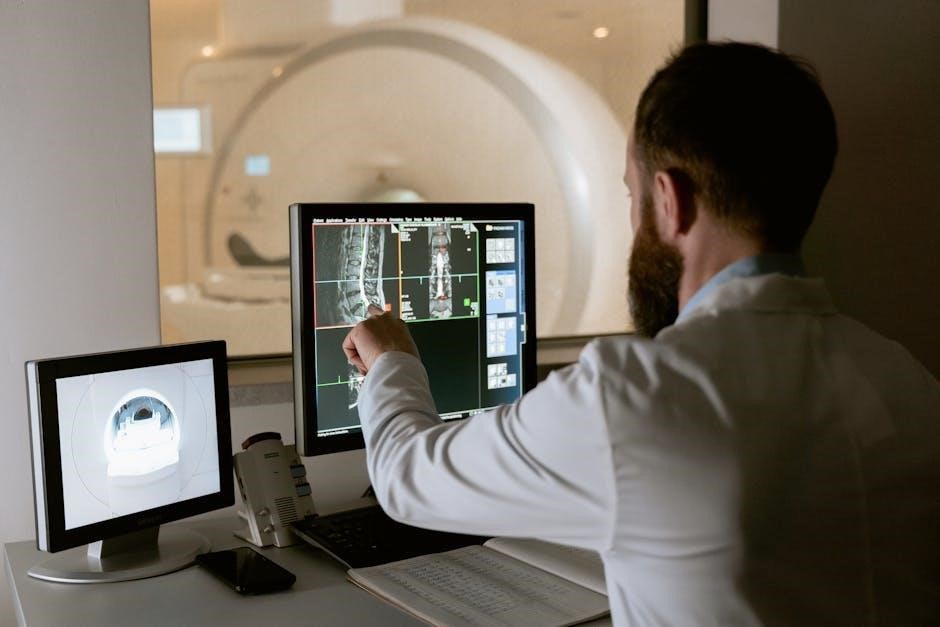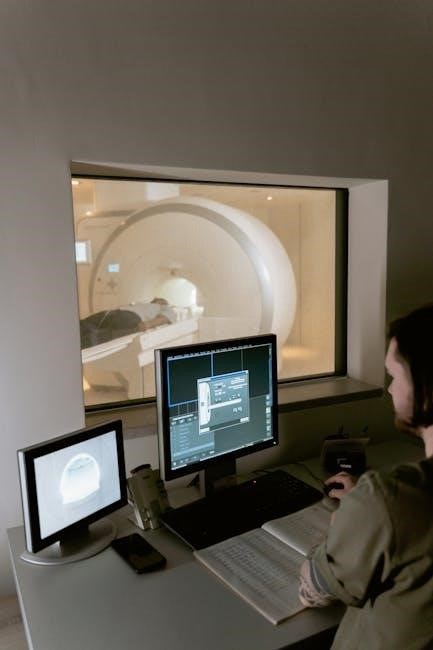The Mississippi Aphasia Screening Test (MAST) is a concise tool designed to assess expressive and receptive language abilities in individuals with suspected aphasia efficiently. Comprising nine subtests, it evaluates various aspects of language function, providing valuable insights for clinicians and researchers.
1.1 Overview of the MAST and Its Purpose
The Mississippi Aphasia Screening Test (MAST) is a brief, efficient tool designed to evaluate expressive and receptive language abilities in individuals with suspected aphasia. Its primary purpose is to quickly identify language deficits and determine the need for further comprehensive assessment. Comprising nine subtests, it assesses various aspects of language function, providing valuable insights for clinicians and researchers in a time-effective manner.
1.2 Brief History and Development of the MAST
The Mississippi Aphasia Screening Test (MAST) was developed by clinicians to address the need for a quick, reliable screening tool for aphasia. Designed based on extensive research, it underwent validation to ensure accuracy and reliability. Over time, the MAST has been refined to enhance its effectiveness, becoming a widely recognized and essential resource for assessing aphasia in clinical settings.

Components of the MAST
The Mississippi Aphasia Screening Test (MAST) is structured to assess both expressive and receptive language abilities through a series of subtests, ensuring a comprehensive evaluation efficiently.
2.1 Expressive Language Subtests
The MAST includes expressive language subtests designed to evaluate an individual’s ability to produce and use language effectively. These subtests assess verbal communication, such as naming objects, following commands, and generating sentences. They also incorporate tasks like describing photos and reading instructions aloud. The focus is on identifying impairments in speech production, word-finding, and grammatical accuracy, which are common in aphasia. This section provides insights into the patient’s ability to express thoughts and communicate ideas clearly.
2.2 Receptive Language Subtests
The MAST’s receptive language subtests assess an individual’s ability to understand and process language. These include tasks like following verbal instructions, identifying objects, and comprehending sentences. Patients may be asked to point to pictures or answer questions based on auditory or written stimuli. This section evaluates auditory and reading comprehension, helping identify deficits in language understanding, which is critical for diagnosing aphasia.
2.3 Administration Time and Structure
The MAST is designed for efficient assessment, typically requiring 10–15 minutes to administer. It is divided into clear subtests, each targeting specific language skills. The test follows a standardized structure, ensuring consistency across administrations. Clinicians are provided with timed instructions to maintain pacing. This concise yet comprehensive approach allows for quick evaluation while ensuring accurate results, making it ideal for clinical settings.

Administration and Scoring Guidelines
The MAST features a streamlined administration process with clear scoring criteria, ensuring clinicians can evaluate aphasia effectively. The test includes detailed instructions for consistent assessment and interpretation.
3.1 Step-by-Step Administration Process
The MAST is administered in a structured sequence to ensure consistency. Clinicians begin with expressive tasks, such as naming objects, followed by receptive exercises like following commands. Each subtest is timed to maintain efficiency. Detailed scoring guides are provided to standardize evaluation. The process emphasizes clear instructions and patient engagement to ensure accurate results. Training is recommended for optimal administration.
3.2 Scoring Criteria and Interpretation
The MAST uses standardized scoring criteria, with each subtest assigned specific point values. Expressive tasks are scored based on accuracy and fluency, while receptive tasks assess comprehension. Total scores are compared to baseline norms to determine aphasia severity. Interpretation guides clinicians in diagnosing aphasia types and monitoring progress over time, ensuring consistent and reliable results.

Clinical Applications of the MAST
The MAST is widely used to assess aphasia in clinical settings, aiding in diagnosis, monitoring recovery, and guiding rehabilitation strategies for patients with communication disorders.
4.1 Identifying Types of Aphasia
The MAST helps differentiate between various aphasia types, such as Broca’s, Wernicke’s, and Anomia, by assessing expressive and receptive language abilities through structured tasks and scoring criteria.
4.2 Monitoring Progress in Aphasia Recovery
The MAST is effective for tracking aphasia recovery by allowing repeated assessments over time. Its structured format ensures consistency, enabling clinicians to measure progress accurately. Regular use helps identify improvements in expressive and receptive skills, supporting informed treatment adjustments. This data provides patients with clear evidence of advancements, enhancing motivation and engagement in their therapy journey.
4.3 Use in Different Clinical Settings
The MAST is adaptable across various clinical environments, including hospitals, rehabilitation centers, and outpatient clinics. Its portability and ease of use make it suitable for bedside assessments or office visits. Clinicians in diverse settings appreciate its efficiency, requiring minimal equipment. This accessibility ensures consistent aphasia screening regardless of the clinical context, making it a versatile tool for speech-language pathologists.

Advantages of the MAST
The MAST offers quick, effective aphasia screening, making it ideal for time-sensitive clinical environments. Its availability as a downloadable PDF enhances accessibility and ease of use for clinicians.
5.1 Efficiency and Time-Effectiveness
The MAST is designed for rapid assessment, typically requiring 10-15 minutes to administer. Its streamlined structure allows clinicians to quickly identify aphasia severity and type, making it ideal for acute care settings. The test’s brevity ensures efficient use of time without compromising diagnostic accuracy, enabling timely intervention and treatment planning for patients with communication impairments.
5.2 Ease of Use for Clinicians
The MAST is designed to be user-friendly, requiring minimal training for clinicians. Its straightforward format and clear instructions ensure ease of administration. The availability of the MAST PDF further enhances accessibility, allowing clinicians to use it effortlessly across various settings. The simple scoring system also reduces administrative burden, making it a practical tool for busy healthcare professionals.
5.3 Availability of the MAST PDF
The MAST PDF is widely accessible, enabling clinicians to download and use it freely. Its availability online simplifies access, ensuring clinicians can easily obtain and print the test materials. The PDF format allows for easy sharing and storage, making it a convenient resource for aphasia screening in various clinical environments.

Limitations of the MAST
The MAST is a brief screening tool, not a comprehensive assessment, limiting its ability to provide detailed language analysis. Its brevity may miss subtle deficits in aphasia.
6.1 Potential for Misdiagnosis
The MAST’s brevity may lead to misdiagnosis, as it doesn’t assess all language domains in depth. Patients with mild aphasia or those with cognitive impairments may be overlooked, resulting in inaccurate conclusions. Clinicians must supplement the MAST with comprehensive evaluations to ensure reliable diagnoses and tailored interventions for individuals with aphasia.
6.2 Limited Depth in Language Assessment
The MAST’s concise design may limit its ability to thoroughly assess complex language functions. While it effectively screens for aphasia, it doesn’t delve deeply into subtle deficits in expression, comprehension, or pragmatics. This brevity can result in an incomplete language profile, necessitating supplementary testing for a comprehensive evaluation of aphasia severity and specific impairments in individuals.
6.3 Dependence on Patient Cooperation
The MAST’s effectiveness heavily relies on the patient’s ability and willingness to participate. Factors like fatigue, motivation, or cognitive impairments can impact performance, potentially leading to inaccurate results. Clinicians must ensure patients are adequately rested and motivated, providing clear instructions and a supportive environment to maximize cooperation and obtain reliable assessment outcomes.

Resources and Tools Related to the MAST
The MAST PDF is a primary resource for clinicians. Additional aphasia assessment tools and training materials support comprehensive patient evaluation and effective clinician preparation.
7.1 Downloading the MAST PDF
The MAST PDF is readily available for download from official medical or rehabilitation websites. It includes detailed instructions, test forms, and scoring guidelines. Clinicians can access it by searching for “Mississippi Aphasia Screening Test PDF” on academic or healthcare platforms; Ensure the source is reliable to maintain test integrity. The PDF is often free and easily printable for clinical use.
7.2 Additional Aphasia Assessment Tools
Beyond the MAST, clinicians use tools like the Boston Naming Test, Western Aphasia Battery, and Token Test for comprehensive aphasia evaluation. These tools assess naming, auditory comprehension, and language processing. They complement the MAST by providing deeper insights into specific language deficits. Clinicians often combine these assessments for accurate diagnosis and tailored rehabilitation planning.
7.3 Training Materials for Clinicians
Clinicians can access training materials, such as the MAST PDF guide, to improve administration accuracy. Supplementary resources include workshops, webinars, and case studies. These tools enhance understanding of aphasia assessment and interpretation. Training materials emphasize consistent administration and scoring, ensuring reliable results for effective patient care and rehabilitation planning.

Case Studies and Clinical Examples
The MAST PDF highlights real-world applications, showcasing its effectiveness in diagnosing and monitoring aphasia. Case studies demonstrate practical uses, aiding clinicians in understanding patient outcomes and treatment planning.
8.1 Successful Implementation in Patient Care
The MAST PDF has proven effective in clinical settings, enabling accurate diagnoses and monitoring of aphasia progression. Clinicians report successful implementation in stroke rehabilitation, with the test aiding in tailored treatment plans. Its brevity and clarity make it a valuable tool for assessing patients with varying degrees of language impairment, ensuring targeted interventions and improved patient outcomes.
8.2 Challenges Faced During Administration
Administrating the MAST PDF can present challenges, such as patient fatigue or difficulty understanding instructions. Individuals with severe aphasia may struggle to respond accurately, leading to incomplete assessments. Additionally, emotional distress or cognitive impairments can impact performance. Clinicians must ensure clear communication and adapt testing strategies to accommodate these challenges, sometimes requiring additional time or alternative methods to achieve reliable results.
8.3 Real-World Applications and Outcomes
The MAST PDF is widely used in clinical settings to assess aphasia effectively. It aids in identifying language deficits, guiding rehabilitation plans, and monitoring recovery progress. Clinicians report improved patient outcomes due to early and accurate diagnoses. However, occasional inconsistencies in results highlight the need for complementary assessments. Overall, the MAST remains a valuable tool in aphasia management and recovery tracking.

Future Directions and Research
Future research may focus on updating the MAST PDF to incorporate digital tools, improving accessibility, and expanding its cultural adaptability for diverse patient populations globally.
9.1 Potential Updates to the MAST
Future updates to the MAST PDF may include digital enhancements for easier administration, expanded cultural adaptations, and additional subtests to assess a broader range of language functions, improving its applicability and accuracy in diverse clinical settings.
9.2 Integration with Other Assessment Tools
The MAST can be integrated with other aphasia assessment tools to enhance comprehensive evaluation. Combining it with tests like the Boston Naming Test or Western Aphasia Battery allows clinicians to assess a broader range of language functions. This integration improves diagnostic accuracy and supports tailored rehabilitation strategies, offering a more holistic approach to patient care strategies.
9.3 Expanding Accessibility and Use
Efforts to expand the MAST’s accessibility include translating the test into multiple languages and developing digital formats. Clinicians can now access the MAST PDF easily, enabling widespread use globally. Additionally, training programs are being implemented to familiarize speech therapists in diverse settings with its administration, ensuring broader application and consistent aphasia screening standards worldwide.
The MAST is a valuable tool for aphasia screening, offering efficiency and accessibility. Its availability as a PDF enhances clinical utility, benefiting both clinicians and patients.
10.1 Summary of Key Points
The Mississippi Aphasia Screening Test (MAST) is a concise tool for assessing aphasia, focusing on expressive and receptive language abilities. Its efficient structure allows for quick administration, making it accessible for clinicians. The MAST PDF is widely used in clinical settings to identify and monitor aphasia, providing valuable insights for patient care and rehabilitation planning.
10.2 Final Thoughts on the MAST’s Importance
The MAST is a vital tool in aphasia assessment, offering clinicians a practical and efficient method to evaluate language impairments. Its simplicity and accessibility, particularly through the MAST PDF, make it indispensable for early identification and monitoring of aphasia. By enabling timely and accurate diagnoses, the MAST contributes significantly to improving patient outcomes and rehabilitation strategies in clinical practice.
References and Further Reading
Academic studies and citations validate the MAST’s reliability. Recommended literature for clinicians includes research papers and guides on aphasia assessment, available alongside the MAST PDF.
11.1 Academic Studies and Citations
Several academic studies validate the Mississippi Aphasia Screening Test’s reliability and effectiveness. Research highlights its efficiency in assessing aphasia, with citations emphasizing its practicality in clinical settings. Studies demonstrate strong inter-rater reliability, making it a trusted tool for speech-language pathologists. Citations also underscore its validity in distinguishing between aphasia types, aiding in accurate diagnoses and treatment plans. Peer-reviewed articles support its widespread use in neurology and rehabilitation fields.
11.2 Recommended Literature for Clinicians
Clinicians are encouraged to explore literature on aphasia assessment techniques, particularly those focusing on the MAST. Recommended texts include guides on interpreting test results, case studies, and evidence-based practices in aphasia rehabilitation. Additionally, journals specializing in speech-language pathology often publish updates on aphasia screening tools, providing clinicians with current research and practical insights to enhance patient care and diagnostic accuracy.

FAQ About the MAST
The MAST is a concise tool for assessing aphasia in stroke patients, focusing on language abilities and communication skills, with clear scoring guidelines for accurate results.
12.1 Common Questions and Answers
- Q: What is the MAST?
A: The Mississippi Aphasia Screening Test assesses language abilities in individuals with aphasia, focusing on expressive and receptive skills. - Q: Is the MAST PDF available for free?
A: Yes, the MAST PDF can be downloaded free of charge from various clinical resources and academic websites. - Q: How long does the MAST take to administer?
A: The test is designed for quick assessment, typically taking 10–15 minutes to complete.
12.2 Clarifying Misconceptions
Some believe the MAST is only for severe aphasia, but it suits all severity levels. Others think it’s time-consuming, though it’s designed for quick assessments. Additionally, there’s a misconception that the MAST requires specialized training, while it’s intended for various clinicians. These clarifications ensure proper understanding and effective use of the tool in clinical settings.
12.3 Troubleshooting Administration Issues
Common issues during MAST administration include patient fatigue, environmental distractions, or difficulty understanding instructions. To address these, ensure a quiet setting, use visual aids, and allow breaks as needed. Clinicians should also verify that all tasks are administered correctly to avoid scoring errors and ensure accurate results.
